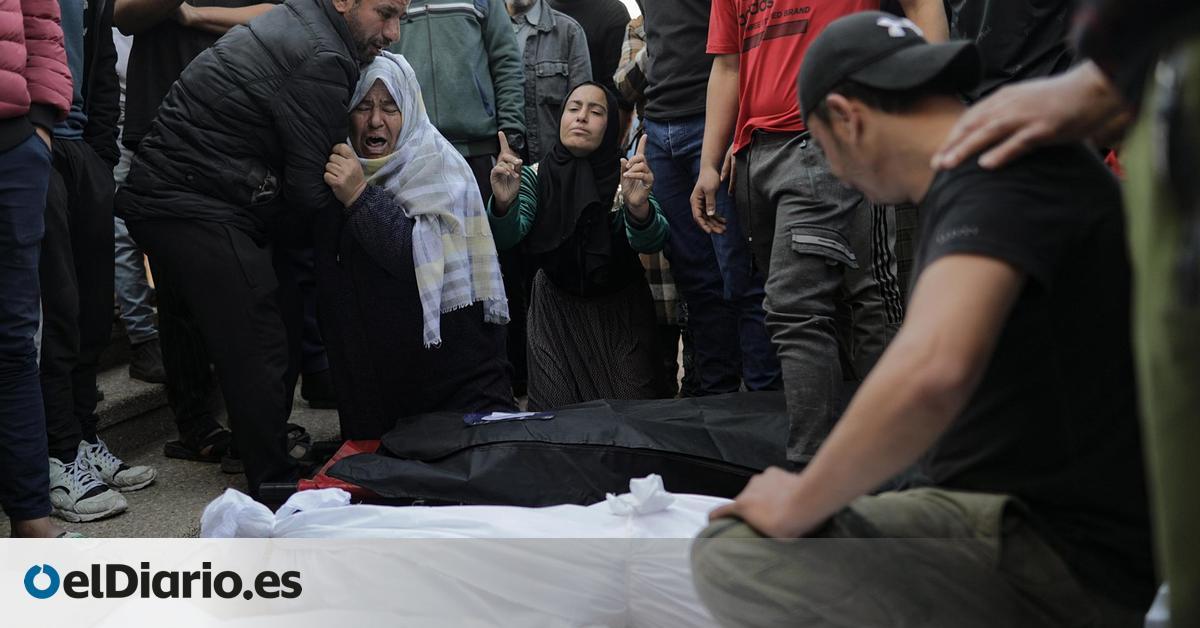
After two and a half months of war in Gaza, the number of deaths in the Strip this week has exceeded the tragic figure of 20,000, according to local authorities, who estimate that some 7,000 people are missing or under the rubble of bombed buildings. so the number of fatalities could be higher. But Gazans, apart from the incessant attacks by the Israeli Army, may also begin to die of hunger due to the serious lack of food and drinking water.
Several UN agencies, including the World Food Program (WFP), warned in a report published on Thursday that more than a quarter of Gaza’s population (577,000 people) “has exhausted its food reserves, cannot cope to the situation and looks into the abyss of catastrophic hunger and starvation.” This means that at least one in four Gaza households is currently suffering from extreme hunger, and there is a risk of famine if access to food and clean water, as well as health and sanitation services, is not restored.
Israel cut off the supply of water, electricity and fuel to the Strip a few days after the start of the war as a punishment for the Hamas attacks on October 7, in which some 1,200 Israelis were killed and more than 200 were kidnapped. Since then, basic supplies and humanitarian aid have entered Gaza in dribs and drabs.

“No one in Gaza is safe from hunger”
“The WFP has been warning about this catastrophe for weeks. Tragically, without the continued safe access we have been calling for, the situation is now desperate, and no one in Gaza is safe from hunger,” WFP Executive Director Cindy McCain said in a statement. “We cannot stand by and watch people starve. “Humanitarian access is necessary now for supplies to flow into and through Gaza and for civilians to safely receive life-saving aid,” McCain added.
The WFP noted that the seven-day truce at the end of November – agreed to by Israel and Hamas, with the mediation of Qatar, the United States and Egypt – allowed the entry and distribution of aid in the Strip and that the reopening of the Kerem border crossing Shalom between Gaza and Israel can help in that regard, as long as “operational conditions within Gaza exist that allow for safe and orderly deliveries to all people in need.”
Also the NGO Action Against Hunger, which participated in the preparation of that report, warned that almost “all households in Gaza skip meals every day and in four out of every five homes in the north, and in half among the displaced In the south, families spend entire days and nights without eating anything.” Like the WFP, the organization highlighted that “this situation could be reversed immediately with greater access for humanitarian aid.”
“Everything we are doing is insufficient to meet the needs of two million people. It is difficult to find flour and rice, and people must wait hours to have access to latrines and to wash,” denounced Noelia Monge, emergency manager for Action Against Hunger, who recently visited the area.
With malnutrition on the rise among Gaza children, diarrheal conditions become deadly
Children – of the total victims in Gaza, more than 8,000 are minors, according to the Gazan Government – are the ones who bear the brunt, because they are the most vulnerable, especially newborns. Ricardo Pires, spokesperson for the UN Children’s Fund (UNICEF), warns that diseases represent another risk to the lives of children. “Cases of diarrhea in children are above 100,000, more than double what they were before the conflict, and with malnutrition on the rise among children in Gaza, diarrheal diseases become fatal,” he explains to elDiario.es. .
“The vital supplies they desperately need to survive are not reaching them due to shelling and fighting. Hundreds of thousands of displaced children in the southern Gaza Strip only have access to between 1.5 and 2 liters of water a day, far below the recommended amount just to survive,” details Pires. That amount is three liters a day, at least. In a humanitarian emergency, 15 liters would be needed for drinking, washing and cooking.
“In this scenario and without sufficient drinking water, food and sanitation – which only a humanitarian ceasefire can bring – the deaths of children from diseases will very soon exceed those killed in bombings,” laments the spokesperson. “Children need an immediate ceasefire and the opening of all humanitarian corridors so that aid can reach them, and so that UNICEF and other humanitarian organizations can operate safely on the ground to distribute supplies.”
No agreement for a humanitarian truce
However, this week, the possibility of a humanitarian ceasefire has become even further removed with the blockage of negotiations between Israel and Hamas, which seemed to have gained new momentum a few days ago and have quickly stalled. The two sides have spoken with Qatari and Egyptian mediators, but their positions seem very far apart: Hamas calls for a complete cessation of hostilities, before negotiating on the release of the hostages who remain in Gaza in the hands of this group and other Palestinian militias. ; Israel refuses to declare an indefinite ceasefire and only agrees to negotiate an exchange of hostages for Palestinian prisoners held in its jails, applying the same terms of the previous agreement – which allowed a pause in fighting from November 24 to November 1. December-. In those seven days, the militants freed more than one hundred hostages and Israel released 240 Palestinian prisoners and minors.
A source familiar with the negotiations tells elDiario.es that “the talks between Israel and Hamas through mediators continue in an attempt to break this deadlock.” An agreement seemed possible after the head of the Israeli Intelligence Services, David Barnea, the head of the US CIA, William Burns, and the Prime Minister of Qatar, Mohammad Bin Abdulrahman Al Thani, met in Poland last Monday. According to that source, who has requested anonymity, the process is slow and “significant progress has not yet been made” in the negotiations.
A senior Israeli official, quoted by local media, said at the end of the week that there are no negotiations for the release of the hostages, although he assured that “the time has come to renew the framework formulated in the previous agreement.” “We are prepared to continue where we left off: the liberation of women and children. We need to start with them,” he declared, according to the Haaretz newspaper. The sources consulted by that Israeli media have explained that the current negotiations are more difficult and complex than the previous ones, and the statements of the Israeli Prime Minister, Benjamin Netanyahu, do not help to reduce the tension between the two parties. Netanyahu has once again insisted that Israel will not stop its offensive until it ends Hamas and that its leaders and fighters can only “surrender or die.”
The international community has also been blocked in a week in which the UN Security Council has repeatedly postponed the vote on a resolution to call for an end to the war due to the lack of consensus on the terminology used in the text. . The first version drafted by the United Arab Emirates called for “a cessation of hostilities” but the US raised objections because Washington and its ally, Israel, want to leave the door open to their resumption.
Finally, this Friday the Security Council managed to approve a resolution, with the abstentions of the US and Russia – for very different reasons – in which the highest body of the United Nations requests to “create the conditions for the cessation of hostilities” in Gaza, a weak formula compared to the original text drawn up by the United Arab Emirates, which had to be modified several times throughout the week. The resolution emphasizes that humanitarian aid access to the Strip must be “full, secure and unhindered” and calls for the creation of a UN mechanism to expedite and monitor the delivery of aid.
Overcrowded and hungry
While diplomacy has not yet managed to stop the violence, Israel continues its offensive – which it has expanded to the south of the Strip, after the truce that ended on December 1 – and is now focusing on the city of Khan Younis, the largest from the south, where the Army says Hamas leaders are located. Since December 1, more than 2,000 Palestinian militants have been eliminated, according to military spokesman Daniel Hagari, and ground troops have strengthened their control of the northern Strip.
In mid-October, the Army had asked northern residents to evacuate to the south of Wadi Gaza, a valley that runs through the territory and represents a natural dividing line between its northern and southern halves. It later asked them to move even further south, towards Gaza’s border with Egypt, as it expanded its operations in the Strip. The UN estimates that 1.9 million people (about 85% of the population) have left their homes since the start of the war, due to Israel’s warnings or attacks, and many of them are in the south, overcrowded in the Rafah area, the southernmost area, where the population density is four times higher than before the conflict.

The Gaza population is overcrowded in the Rafah area
GRAPHIC: IGNACIO SÁNCHEZ. SOURCE: OCHA

The population of Gaza is
overcrowded in the Rafah area
GRAPHIC: IGNACIO SÁNCHEZ. SOURCE: OCHA
Around 1.4 million people are sheltered in UNRWA facilities, many of which were former schools offering free education to Gazans. “We have up to 70 people in a classroom, hundreds of people share a bathroom, a shower,” the spokesperson for that organization, Juliette Touma, tells elDiario.es. “People have lost everything, they are missing everything, from food to water, as well as hygiene supplies. Women and girls need pads; The chronically ill and the elderly need medicine, medical assistance,” says Touma, who recently visited the Strip. “Some told us they can only eat once a day, if at all.”
But above all, “they need security and protection,” because UNRWA buildings have also been the target of Israeli attacks dozens of times and some 300 people have died in them, according to the spokesperson. Touma reiterates what UN representatives have been saying for weeks: “There is no safe place in Gaza.”
Source: www.eldiario.es

